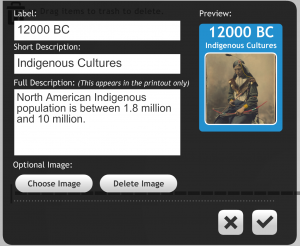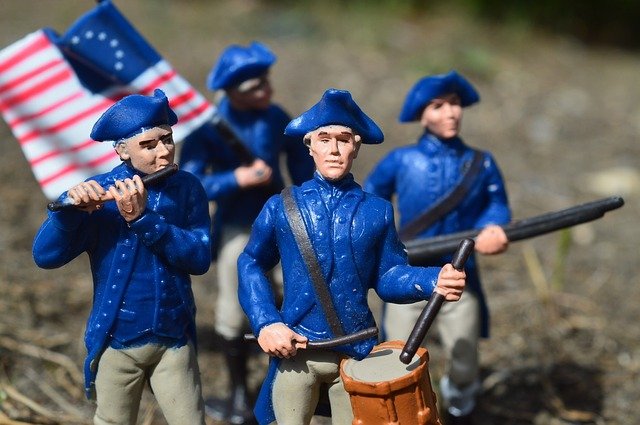Introduction to US History Day (the first one, there will be others).
There are thousands of significant events in the History of the USA. There are hundreds of well known events. However, for this theme we are covering an overview of how America today came to be. The things left out are not less important. Each of of the topics we cover is it’s own topic. We could do a unit only covering the history of the indigenous peoples, the US / Mexican border and history there, or the history of slavery, and we will cover these things in more depth in other themes. The objective of this unit is to enable you to develop a chronologically secure knowledge and understanding of American history. This means that you will have a broad understanding of how modern America came to be and a firm understanding of the timescale in which this happened.
You are going to watch, read, and listen to stories, explanations, and images and add (many of) them to a timeline. The timeline software we are going to use is here. Type in your name and the title (something like US History). Click start and save your timeline on your computer. Save it regularly, after each new item is added.
A timeline is a way to show events chronologically, or in order of earliest to latest. Here are some examples of timelines.
You will need to find images to use on your timeline. Some resources for free images are here.
What you will produce:
A timeline complete with dates, notes, and images.
Overview
A timeline of the 50 states.
Timeline Item 1
12000 BC – Indigenous Cultures.
Native North American peoples who occupied North America before the arrival of the Europeans in the 15th cent.
They have long been known as Indians because of the belief at the time of Columbus that the Americas were the outer reaches of the East Indies.
Some accept evidence of Native American existence in the Americas back more than 25,000 years, while many others believe that people arrived later than that, perhaps as recently as 12,000 years ago.
The Native American population of the area North of Mexico is conservatively estimated to have been about 1.8 million, with some believing the population to have been as large as 10 million or more.

Update your timeline with a date, description, and image. It should look something like this and be right at the very beginning of your timeline.
Timeline Item 2
1492 – Did Christopher Columbus discover America?
The explorer Christopher Columbus made four trips across the Atlantic Ocean from Spain: in 1492, 1493, 1498 and 1502. He was determined to find a direct water route west from Europe to Asia, but he never did. Instead, he accidentally stumbled upon the Americas. Though he did not really “discover” the New World—millions of people already lived there—his journeys marked the beginning of centuries of transatlantic conquest and colonization.
Minnesota recently changed Columbus Day to Indigenous Peoples’ Day.
Update your timeline.
Timeline Item 3
1620 – 1664 – The Mayflower & the Plymouth Colony.
After arriving in America, the Pilgrims searched the coast of New England for a good place to build a settlement. They eventually found a location called Plymouth. It had a calm harbor for their ship, a river for fresh water, and flat lands where they could plant crops. It was here that they built their village and established the Plymouth Colony.
Update your timeline.
Timeline Item 4
1775 – The American Revolution
The American Revolution was a colonial revolt that took place between 1765 and 1783. The American Patriots in the Thirteen Colonies won independence from Great Britain, becoming the United States of America. They defeated the British in the American Revolutionary War (1775–1783) in alliance with France and others.
Update your timeline.
Timeline Item 5
1783 – The Treaty of Paris
The Treaty of Paris of 1783 formally ended the American Revolutionary War. American statesmen Benjamin Franklin, John Adams and John Jay negotiated the peace treaty with Great Britain. In the Treaty of Paris, the British Crown formally recognized American independence and ceded most of its territory east of the Mississippi River to the United States, doubling the size of the new nation and paving the way for westward expansion.
Update your timeline.
Timeline Item 6
1791 – The Bill of Rights
The first 10 amendments to the Constitution make up the Bill of Rights. James Madison wrote the amendments, which list specific prohibitions on governmental power, in response to calls from several states for greater constitutional protection for individual liberties. For example, the Founders saw the ability to speak and worship freely as a natural right protected by the First Amendment.
1. The First Amendment grants freedom of speech, freedom of press, freedom of assembly, and the right to protest.
2. The Second Amendment grants the right to bear arms
3. The Third Amendment states that soldiers cannot take over a home during war or peace without the homeowner’s permission.
4. The Fourth Amendment protects Americans from unreasonable and unlawful search and seizure of property.
5. The Fifth Amendment allows all citizens due process and states that a person cannot be forced to serve as a witness against himself when accused of a crime.
6. The Sixth Amendment provides a speedy and public trial by jury for all who are accused of a crime.
7. The Seventh Amendment also allows a trial by jury to be held for certain civil disputes.
8. The Eighth Amendment prevents those accused of suffering cruel and unusual punishment.
9. The Ninth Amendment states that no one’s Constitutional rights should be used to infringe upon the rights of another citizen.
10. The Tenth Amendment provides each state with powers that are not specifically assigned to the nation’s government in the Constitution.
Update your timeline.
Timeline Item 7
1800 – Washington DC
The city of Washington was created to replace Philadelphia as the nation’s capital because of its geographical position in the center of the existing new republic. On June 3, 1800, President Adams moved to a temporary residence in the new capital as construction was completed on the executive mansion. On November 1, the president was welcomed into the White House.
Update your timeline.
Timeline Item 8
1803 – Louisiana Purchase
The Louisiana Purchase(1803) was a land deal between the United States and France, in which the U.S. acquired approximately 827,000 square miles of land west of the Mississippi River for $15 million.
Update your timeline.
Timeline Item 9
1830 – Indian Removal Act & The Trail of Tears.
t the beginning of the 1830s, nearly 125,000 Native Americans lived on millions of acres of land in Georgia, Tennessee, Alabama, North Carolina and Florida–land their ancestors had occupied and cultivated for generations. By the end of the decade, very few natives remained anywhere in the southeastern United States. Working on behalf of white settlers who wanted to grow cotton on the Indians’ land, the federal government forced them to leave their homelands and walk thousands of miles to a specially designated “Indian territory” across the Mississippi River. This difficult and sometimes deadly journey is known as the Trail of Tears.
And the Heavens Cried – A poem.
Update your timeline.
Timeline Item 10
1849 – The Underground Railroad.
The Underground Railroad was a network of people, African American as well as white, offering shelter and aid to escaped slaves from the South. It developed as a convergence of several different clandestine efforts. The exact dates of its existence are not known, but it operated from the late 18th century to the Civil War, at which point its efforts continued to undermine the Confederacy in a less-secretive fashion.
The Underground Railroad – Escape from Slavery
The sounds of slavery. Recordings of the sounds of slavery to listen to – powerful.
Update your timeline.
Timeline Item 11
1861 – The American Civil War.
The American Civil War was the greatest war in American history. 3 million fought – 600,000 paid the ultimate price for freedom. And a war for freedom it was. The desire for freedom traveled deeper than the color of skin and farther than the borders of any state.
Update your timeline.
Timeline Item 12
1863 – Emancipation.
The Emancipation Proclamation, or Proclamation 95, was a presidential proclamation and executive order issued by United States President Abraham Lincoln on January 1, 1863. It changed the federal legal status of more than 3.5 million enslaved African Americans in the designated areas of the South from slave to free.
Update your timeline.
Timeline Item 13
1959 – The 49th and 50th States.
The United States purchased Alaska from the Russian Empire on March 30, 1867, for 7.2 million U.S. dollars at approximately two cents per acre. The area went through several administrative changes before becoming organized as a territory on May 11, 1912. It was admitted as the 49th state of the U.S. on January 3, 1959.
Hawaii is the 50th and most recent state to have joined the United States, having received statehood on August 21, 1959. Hawaii is the only U.S. state located in Oceania, the only U.S. state located outside North America, and the only one composed entirely of islands. It is the northernmost island group in Polynesia, occupying most of an archipelago in the central Pacific Ocean.
Update your timeline. Make sure the dates are spread out and make sense. Do a final save and print it out.
Wrap up!
The History of the USA is awe-inspiring and incredibly sad at the same time. So much pain and so much pride. This was merely a brief overview and doesn’t even begin to sum up how (what is possibly) the most powerful country on the planet came to be. It’s just an introduction. We need to learn so much more about the indigenous peoples that were here before and still live amongst us. We need to learn how slavery came to be and its connection with Europe. By knowing the past history of our country maybe we can understand our present and nourish our future. Carry on learning.
And just for fun…
